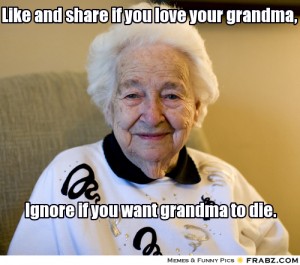This article originally appeared in PR Daily.
If you work in the marketing industry (“social media” is not an industry), you’ve probably either read or heard about this anonymous piece in Digiday and either scoffed at or empathized with the author’s plight.
If you haven’t, here are two of the most resonant points:
I sat in a brainstorm. We came up with a bunch of content ideas for our brands’ social channels—images, GIFs, and lines of witty copy. I went back to my desk, opened a container of leftover lo mein, and realized I’d wasted the last four years of my life.
And:
The underlying issue is that social departments place too much value on engagement. Those “likes,” “comments,” “shares,” “re-tweets,” and “pins” are the metrics that social content creators use to (1) judge success and (2) dictate what future content looks like. Here’s the catch. The people who are engaging with that content are predominantly worthless.
As someone who works at an agency that provides similar support to our clients, I empathized. I’ve been that anonymous author. I’ve lived that life. I feel your pain, anonymous author.
Here’s the thing, though: Empathy and pity aren’t going to solve the problem.
 Instead of going back to our leftover lo mein to come up with more variations of “Keep Calm and Carry On” posts while questioning our life choices, I figured it would be more productive to offer tips on how to get out ourselves and our clients out of this rut. (Unless your job and/or bonus depends on amassing more “likes,” fans, and followers—in which case, have I got a lead for you.)
Instead of going back to our leftover lo mein to come up with more variations of “Keep Calm and Carry On” posts while questioning our life choices, I figured it would be more productive to offer tips on how to get out ourselves and our clients out of this rut. (Unless your job and/or bonus depends on amassing more “likes,” fans, and followers—in which case, have I got a lead for you.)
First things first—stop taking yourself so seriously. You’re managing Facebook and Instagram, not performing brain surgery. Stop thinking your customers are waiting with bated breath for your content. They’re not.
Stop treating your social media like paid media, and start treating it for what it is—a place for brands to come out of their ivory towers and interact, listen, talk, and share with their customers. Experiment. Be on your customers’ journey with them. Try new things. Engage in actual conversations. Act as though you actually care about what your customers need and want rather than what will get the most “likes.”
“But,” you say, “my client/boss wants to see the ROI of our efforts and if I can’t show the numbers going up, our budgets are going to get cut/I’m going to get fired!”
Here’s where you change the conversation. Review the metrics you’ve been using, and throw them away. Build a new key performance indicator chart, one that’s actually tied to your business goals.
If your goal is to increase e-commerce sales, show how much traffic is coming in through your social channels. If your goal is to improve your brand’s online reputation, point to the quality of the search results. If your goal is to increase awareness, point to the total number of mentions across all media channels. If your goal is customer service, track how many cases you’ve resolved via social media. If your boss/client gives you a hard time about wanting to see more “likes,” comments, and pins, that’s because you haven’t given her any other metrics from which to judge success. Figure out what role you think social media should be playing for your organization and measure against that.
You also should work with everyone in the marketing mix. Figure out what role social media plays in that regard. Figure out how you can use social media to help advance the other areas. Figure out how they can help advance social media. As a component of marketing, social media does not exist in a vacuum—and neither can you.
Rather than fighting for more dollars, headcount, or attention, look at the bigger picture and take a realistic view of where social media can and should fit in. It’s quite possible you’re stuck in this never-ending loop of crappy content because you have a much bigger budget than that of other areas and your clients (internal and external) want to get their money’s worth.
Don’t be afraid to look at the bigger picture and say: “What if we took some of the money we have allocated to Facebook ads and reallocated that to PR so that we can get some more earned media coverage? That would, in turn, drive more social engagement, because we’d be tapping into those publications’ social media channels, too.”
Finally, be ready to find and create content that makes your brand/organization unique. Everyone and everything has a story, so instead of following some social media guru’s best practices formula for online content that will increase followers, friends, and comments, think about the story you want to share and the conversations your customers actually want to have.
When building your social media content calendar, create and share content about your organization’s history, or the “why” behind some of your business decisions, or your organizational culture, your causes, or new product uses. Maybe it’s just to ask them what they think; you might be surprised at what you find out. If you’re scared of how your “fans” will react, you have problems that go beyond social media.
The Digiday piece struck a chord with so many because we’ve let our excitement for these channels overtake our better judgment. All is not lost—let’s not resign ourselves to a fate of leftover lo mein and crappy content. Let’s admit our faults, adjust our mindsets, and push forward.




Comments Off on Stop Wasting Years of Your Life, Social Media Strategists